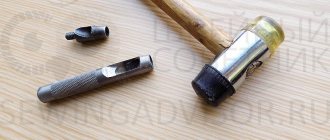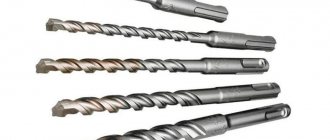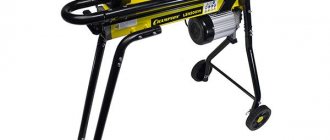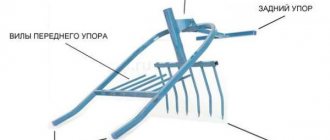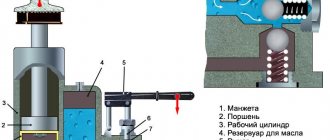Setting up a walk-behind tractor
Working with a walk-behind tractor begins with setting it up. It depends, first of all, on the area of the plowed area, as well as on the quality of the soil. Some universal rules will help you set up your equipment correctly:
- The recommended diameter of the lugs is 50-60 cm, and the width is 18-20 cm. If the dimensions are smaller than those specified, the equipment will not make it possible to make an even furrow; it will be driven on different sides.
- It is preferable to choose a solid wheel rim so that earth does not accumulate on it.
- The weight of the unit must be less than 70 kg, otherwise it will constantly slip.
- The position of the machine itself when plowing should be such that its entire base is completely in contact with the soil. Otherwise, the plowing depth will either be too great, or, conversely, plowing will not work at all.
- When attaching the plow to the coupling device, the fastening nuts are not fully tightened. This leaves the possibility of further regulation. Using just two pins, you can easily connect the plow to the mounting eyelet.
Leveling the area using a walk-behind tractor and cultivator
This type of equipment is suitable not only for agricultural needs. A cultivator or walk-behind tractor can be used for landscaping work. You can level your dacha plot with improvised means, a shovel and a rake, as well as with the help of utility equipment, but if the area is hilly or replete with stumps and a developed root system, heavier equipment may be required.
Leveling the area with a cultivator is only possible if there are minor unevennesses that can be eliminated without resorting to additional technical means (a tractor with a bucket, etc.). The walk-behind tractor is capable of diving a little deeper, but on average, the diving area reaches 15-17 cm. Further leveling of the area occurs with the help of a rake. The loosened soil should be evenly distributed throughout the area.
If the soil on the site is too hard, rocky, or if there are stumps that have not been uprooted, etc., it would be better to resort to the services of a tractor. It would be better to dig up solid objects, such as a large stone buried a considerable distance into the soil, or an overgrown rosehip bush deeply rooted in the area, using a regular bayonet shovel. Only after removing parts that interfere with loosening and removing large debris can you begin to work using a walk-behind tractor.
It is important to remember that operating a walk-behind tractor and cultivator on hilly terrain and other uneven terrain is associated with an increased risk.
Plowing a walk-behind tractor with a plow
Experienced experts advise novice gardeners to begin their plowing work by stretching the cord along the first row. This simple procedure will make the furrow even.
When plowing other rows, the walk-behind tractor wheel will pass along the finished furrow of the first row. For this reason, all other furrows will be smooth; no additional measures are required.
In order to make plowing the garden convenient, the procedure must be carried out along a long row. This will help eliminate additional effort.
Plow adjustment
Plowing quality will not be good if the plow is not adjusted correctly. To ensure normal operation it is necessary:
- The minitractor needs to be raised slightly above the ground. This can be achieved by selecting small stands 15 cm high (boards or bricks). The greater the required depth of plowing the soil, the higher the stands should be: if the operation is carried out in the fall, the height of the stands is made 20-25 cm. In the spring, the height is left lower - 10-20 cm.
- Install the hitch without deviating from the instructions of the equipment manufacturers. The edge of the ploughshare must be in full contact with the ground, while the plow stand must be installed vertically and the beam horizontally.
- By turning the handle at the base of the walk-behind tractor to the left, you can process the not yet plowed strip. This will also help prevent the car from getting stuck. When turning the unit, you must try to ensure that its right wheel remains opposite the already completed furrow.
Plowing depth
To achieve the required plowing depth, you need to pay attention to the weight of the walk-behind tractor. It is better to choose the one that is heavier. You can add weight yourself by attaching additional weights to the wheels.
The first furrow is made no more than 10 cm deep. You need to plow slowly and without putting pressure on the machine. If it happens that the equipment overheats, it is turned off for half an hour.
In relatively soft soil, the metal knife goes into the ground at the distance of a shovel bayonet. If the ground is harder, it will be difficult to achieve this depth the first time. Therefore, the plowing operation is carried out in two or even several stages, each time lowering the plow deeper.
Very hard soil is easier to plow with a walk-behind tractor when wet.
Plowing with a plow
The main plowing should begin only after the trial version has been completed and all the shortcomings have been taken into account.
Two adjacent plowed strips should be spaced no more than 10 cm apart. Adjacent furrows should not cover one another with soil. The right wheel of the machine should be in the middle of the blade of the finished furrow, and not along its base.
By slightly increasing the speed, you can ensure that the surface of the plowing becomes smoother, without lumps. The plow makes it possible to make furrow depths of 15-20 cm.
You can plow the soil efficiently with a walk-behind tractor thanks to the high-speed mode. It is best when the walk-behind tractor has several gears so that the owner can choose the most convenient one for himself.
How much does it cost to plow a field?
Manual cultivation of plots of land is a rather difficult task, and if it is also virgin soil, then it is almost impossible to dig up the soil. Therefore, farmers and summer residents, in order not to plow by hand, try to acquire special agricultural equipment - cultivators, motor-cultivators, walk-behind tractors, mini-tractors and various accessories for them. The equipment will allow high-quality plowing of virgin soil and quickly cultivating plowed lands.
But not every owner of a farm or dacha land has the opportunity to purchase a whole arsenal of motorized equipment. Often the power of a purchased cultivator is simply not enough to cultivate virgin soil or plow an abandoned garden. In this case, you have to turn to the owners of more “serious” agricultural equipment for help - powerful mini tractors and tractors. These high-performance machines become especially popular during the pre-planting and post-harvest seasons. They quickly and efficiently process the field, cultivate, cultivate overgrown turf and virgin soil.
Of course, agricultural machinery services are not cheap. The cost of mechanized work performed by a tractor depends on various factors, in particular:
- prices for fuel and lubricants;
- dimensions of the treated area;
- the degree of neglect of the site, the presence of vegetation on it;
- relief and condition of the soil that will be processed;
- distances from the place where the equipment is parked to the place where it will work;
- the type of excavation work and the agricultural implements used to carry it out.
How much it costs to hire a tractor for plowing virgin soil or cultivating plowed land can be found out on thematic forums where experienced farmers and beginners exchange relevant information with each other and give practical advice. Typically, tractor owners calculate the cost of plowing as follows: all costs of processing + 45-50% (virgin soil, naturally, is more expensive). But it’s difficult to say exactly the final amount, since prices can vary greatly in different regions of the country.
The most expensive work is considered to be tractor work for plowing virgin and arable land using a disc harrow, a tillage cutter and a three-furrow or double-furrow plow (25,000 rubles/1-5 ha). It will cost a little less to disk the earth and mow the grass if you work with a mini tractor using a mounted rotary mower and a tooth harrow (20,000 rubles/1-5 ha). But even at relatively high prices, the services of tractors and mini-tractors are used by many farmers, including owners of garden and country plots. Whatever one may say, plowing and cultivating without equipment is difficult and time-consuming. In addition, this is a very responsible process that cannot be done without time and financial investments. To plow a plot, you can either hire a tractor or dig it yourself.
How to plow with cutters
If you need to plow a small area, it is better to use a cultivator or cutters. They can be purchased separately, but more often they come as part of light and medium-sized walk-behind tractors.
The procedure for cultivating the soil is that the unit is driven along the furrow from edge to edge in high gear. Having turned the walk-behind tractor 180 degrees at the end of the section, the procedure is continued. During plowing, you need to ensure that the rotation speed of the mechanism is low, and the cutters rotate, on the contrary, at high speed.
The cutters must be set strictly horizontally, this will prevent the formation of waves during plowing. The use of cutters is ideal for loosening the soil and eliminating weeds. However, a milling cutter can destroy soil capillaries that prevent moisture from entering the soil.
Loosening increases soil permeability. There is no need to plow the soil twice; this causes the soil to cake.
The most commonly used cutters are saber cutters, as well as models with crow's feet. The first option is used most often. Operations with their help are carried out efficiently and accurately. The second is preferable for removing weeds and cultivating heavy soil. The inconvenience is that such a cutter is not strong enough and needs frequent repairs.
Benefits of using a plow
Using mechanical tools to plow a field greatly simplifies farm work. According to statistics, the yield almost doubles if the field is processed using specialized devices.
The following are the advantages of using motorized plows:
- saving time and getting better results by applying a minimum of effort;
- additional loosening of the soil and subsequent fertilization using one tool;
- uniform cultivation of the land and, as a result, improved structural quality and condition;
- saturation of the soil with moisture and oxygen;
- slowing down the growth of weeds through land cultivation.
Plowing the land with a walk-behind tractor with an adapter
The quality of plowing and its convenience can be improved by turning the plow into a transport and arable module. To do this, it is attached to the frame of the adapter, not the walk-behind tractor. This type of plowing is easier and safer, but less maneuverable. The operating speed can be increased from 5 to 10 km/h.
Adapter – trailer to a walk-behind tractor or a mini tractor from a walk-behind tractor. The functionality of such a unit can be compared with the capabilities of a tractor. The range of tasks increases depending on the attachment.
Some models have a lever used for lifting. This makes controlling the mechanism easier and makes it possible to move it around the site.
Features of virgin soil plowing
How to plow virgin soil correctly? For high-quality processing you will need:
- Motoblock unit weighing at least 100 kg. If it is lighter, the plow simply will not budge.
- A rotary plow, which includes a cutter, a gearbox for connecting to a walk-behind tractor, and transport wheels.
- It would not be superfluous to use special weighting in the form of ballast.
The work of plowing virgin soil must be carried out in stages, each time going deeper and deeper. In addition, soil moisture will make it easier to work with.
Good to know! The direction of plowing needs to be changed every year, since the soil layer is constantly shifting.
Models of walk-behind tractors such as Neva, MTZ, Khoper, and Centaur are in great demand among gardeners. In addition to plowing, they also provide for other agricultural work.
Potatoes are often hilled with walk-behind tractors, that is, a hiller is used instead of a plow. It penetrates into the ground to a shallower depth, thereby differing from the first.
It is also used for harvesting. For this, a special canopy is used that raises the ground. Then it is poured through the grate, as if through a sieve, and only the root vegetables remain on the surface.
Choosing the right model
Before purchasing a walk-behind tractor, you need to determine for what work the unit will be used. The simplest devices are lightweight (up to 100 kg) and are equipped with 4–8 hp engines. With. and are equipped with a small set of working attachments.
They allow you to perform the minimum required list of works:
- plowing;
- disking;
- harrowing;
- ridge catching.
Some devices are universal. They allow the use of additional equipment, for example:
- potato digger;
- snow blower;
- motor pump;
- lawnmower.
Small walk-behind tractors with a 4-5 liter engine. With. and a working area width of 0.5-0.6 m are suitable for plowing a small plot of land not exceeding 15-20 acres in area. For larger plots, more serious equipment is needed. If the size of the plot exceeds 20 acres, it is more advisable to use a unit with a capacity of 7-8 liters. With. and a processing width of 0.7-0.8 m. Land plots up to 1 hectare are cultivated with walk-behind tractors with 9-12 hp engines. With. and a working area width of up to 1 m.
Important! The heavier the earth, the more powerful the unit must be used.
When choosing a walk-behind tractor, you need to pay attention not only to the parameters of the unit, but also to its manufacturer. High-quality models are equipped with engines from well-known manufacturers (Forza, Honda, Subaru), have a disc clutch and gear reducers. Such models are the most reliable and, when using high-quality fuel and oil, last for quite a long time.
What is better to plow: a walk-behind tractor with a plow or a cultivator
Plowing is the simplest soil cultivation operation. If the area of the plot is small and the soil is quite loose, then you can use a cultivator. These devices are lighter and more maneuverable than walk-behind tractors with a plow, and their less powerful engines consume less fuel. If the soil is heavy or you have to plow virgin soil, then you can’t do without a walk-behind tractor. Unlike motorized cultivators, these self-propelled units can cultivate areas using attachments: a plow, a disk, a cutter.
Motoblocks, as a rule, are equipped with rubber pneumatic wheels, which makes it possible to use them as a tractor, for example, when towing a trailer.
Can a walk-behind tractor plow virgin soil?
Unlike a cultivator, which works only on loose soils, a walk-behind tractor can be used for plowing heavy soil, including virgin soil. The ability to use a variety of attachments makes it possible to use a rotary plow, best suited for cultivating neglected areas.

